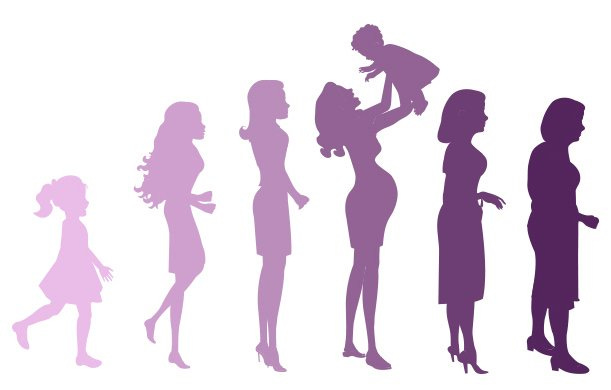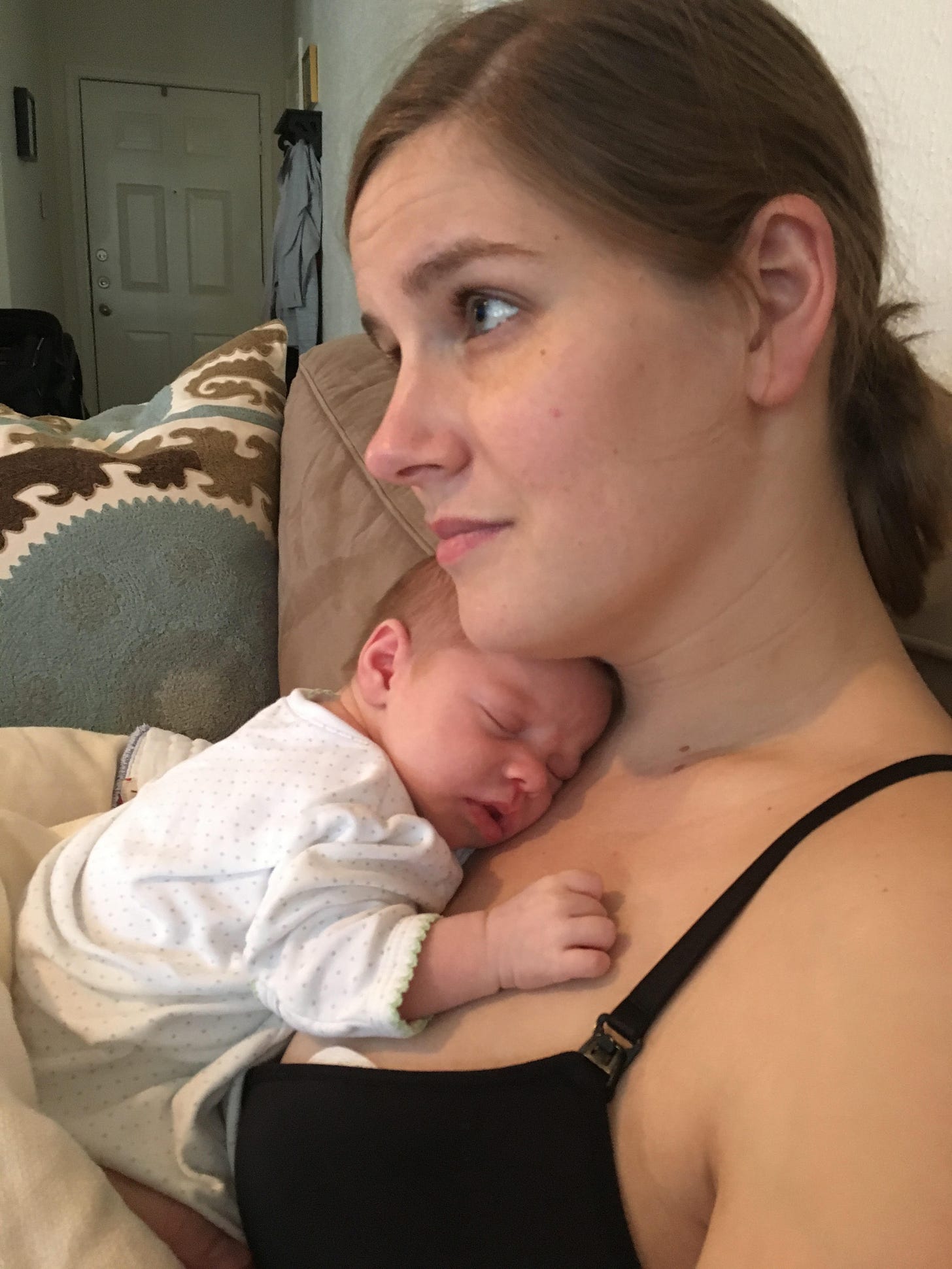More than Birth - the Brain, the Body and Becoming
Matrescence is the neurological and emotional rebirth of a woman.
As women, we progress through several life stages. During infancy and childhood, we were daughters, and we grew into our identities as sisters and friends. We developed our earliest identity of self: sweet and mannerly, curious and spirited, argumentative and challenging, tomboyish and athletic, idealistic and traditional (not an exhaustive list).
Adolescence brought all those tumultuous hormonal and physical body changes. This began in late elementary and middle school, the latter period especially exciting in new and emotional ways. Friendships were more stimulating, yet also heartbreaking. We began to know our own body & form our intuition. We liked certain people and things, sometimes without reason. Often, we could not explain what drew us to certain people. During this period, we started to rebel and formed our own independence from our parents.
Young maidenhood brought about our creative potential, our exploring and learning, and perhaps college. We learned how to navigate friendship and become lovers. Our cognitive brain power peaked at age 22 and our physical strength peaked at age 25. We became workers, holding down jobs and living within boundaries – both physical and financial.
In our late twenties, by age 26 to 29 years, we acquired our executive brain function – when our prefrontal cortex became fully developed. Prior to that milestone, we were only playing at having an organized life. We were still lovers, learning to trust and communicate, and oftentimes we learned to forgive and moved on to another lover.
Older maidenhood, which occurred typically in our 30's, found us settling into our career, but still looking for companionship and pleasure. Our career and making money became more important to us, and we also started to think about marriage and finding a life partner. In this phase, we saw marriage as our greatest commitment, and we embarked on learning to navigate that partnership, calling on more communication, trust, and forgiveness.
Throughout these long years, we acquired and shaped our personal identities as workers, sisters, friends, lovers, partners, and perhaps wives. Yet, after incorporating all these identities, we reserved the most difficult and challenging one for last – becoming a mother.
Our image of motherhood begins when we become pregnant, whether that is planned or unexpected. We imagine ourselves being a mother, recalling our own mother and other mothers who were important in our lives. In our minds, we draw an image of ourselves as mothers while we prepare for birth, buying necessities to care for a baby and thinking about how to accomplish this.
Matrescence – or becoming a mother - challenges us more than all our previous life stages. There are an infinite number of lessons to be learned. The initial one is accepting responsibility to care completely for another human. (If we were forced into a detour here - a pregnancy complication, the birth of a premature baby, or a sick infant, then this process is delayed for some time. It does not go away. It is merely postponed.)
With the birth of our first child, we embark on developing our identity as a mother. Our brains literally become rewired as motherhood changes our female brain, and we undergo some extreme physical, emotional, and behavioral changes during our pregnancy, lactation, and matrescence. I like to think of motherhood as a major developmental milestone for women.
During pregnancy there occur long-lasting reductions in the gray matter within specific regions of our brains, particularly those involved in social cognition. These variations are most prominent in the medial prefrontal cortex, posterior cingulate cortex, and bilateral temporal cortex. These reductions in gray matter probably reflect a refinement or pruning of neural connections to enhance our ability to respond to our infant’s needs.
Rest assured, there is no cognitive decline or impairment during this process of gray matter reduction. Instead, the changes in our brains appear adaptive, improving our emotional regulation and caregiving behavior. Remarkably, these brain changes can still be found two years postpartum, suggesting they are enduring adaptations to motherhood.
We undergo huge hormonal Influences during pregnancy and postpartum with dramatic increases in estrogen, progesterone, oxytocin, prolactin, and cortisol. These hormones help to shape our maternal brain structure and function: oxytocin increases responsiveness to baby cues and promotes bonding, estrogen and progesterone modulate brain plasticity and emotional processing, and cortisol (despite being a stress hormone) plays a role in maternal vigilance and motivation.
Our maternal brain becomes hyper-responsive to our baby’s signals, especially in the early postpartum period. This heightened sensitivity is thought to foster our attunement to and bonding with our infant. Studies using functional MRIs have found that new mothers show structural changes - increased activity in certain brain regions in response to infant stimuli (crying, yawning, frowning, bright-eyed gazing). This results in our developing stronger connectivity in our brain networks related to empathy, reward, and attachment.
Furthermore, our brains adapt to the demands of caregiving through experience-dependent plasticity. This means that the more time we spend with our baby the greater the increase in gray matter located in caregiving-related regions like the prefrontal cortex.
Matrescence poses many physical and psychological changes associated with pregnancy & lactation that new mothers undergo. The psychological and emotional changes we undergo are huge. Matrescence often brings increased emotional sensitivity, empathy, and self-reflection, which may be biologically grounded in our brain’s reorganization. Indeed, pregnancy and matrescence reshape our brains in lasting ways.
Some researchers liken this process of matrescence to adolescence, given the intense identity shift and hormonal surges.
Interestingly, the same brain regions that change during pregnancy are also implicated in mood and anxiety disorders. Women with perinatal depression or anxiety may show different patterns of brain activation and connectivity than the ones described above.
Of course, stress, sleep deprivation, and lack of social support can negatively impact brain plasticity during this sensitive window of matrescence.
Matrescence is best considered a neurological and emotional rebirth of us. All these changes support maternal behaviors, bonding, emotional attunement, and caregiving. While these brain and body adaptations appear to be largely beneficial and adaptive, they may also explain why this period in a woman’s life is vulnerable to mood disorders.
The maternal brain is not just hormonally influenced—it’s structurally and functionally remodeled in a profound transformation that continues to unfold well into the postpartum period. During this long process of matrescence, we transition from lots of estrogen to vastly more empathy in the most complex ways.
If you enjoy my writing and this update, please hit the❤️ button below and restack by hitting the 🔄️ button. Then other people can find my work. Thanks for reading!
References
Hoekzema, E. et al. (2016). Pregnancy leads to long-lasting changes in human brain structure. Nature Neuroscience, 20, 287–296. https://doi.org/10.1038/nn.4458 (Longitudinal MRI study demonstrating gray matter volume reductions in areas involved in social cognition in new mothers. Changes persisted for 2 years postpartum.)
Hoekzema, E. et al. (2022). Adaptations in brain structure and function during motherhood: An updated review of the literature. Current Opinion in Psychology, 45, 101295. H https://doi.org/10.1016/j.copsyc.2021.12.005 (Review of structural brain plasticity across pregnancy and postpartum.)
Brunton, P. J., & Russell, J. A. (2008). The expectant brain: Adapting for motherhood. Nature Reviews Neuroscience, 9, 11–25. https://doi.org/10.1038/nrn2280 (Review of how hormones like oxytocin, estrogen, and cortisol shape maternal brain and behavior.)
Glynn, L. M. et al. (2016). Pregnancy programming and maternal brain plasticity. Trends in Cognitive Sciences, 20(7), 522–531. https://doi.org/10.1016/j.tics.2016.05.001 (How pregnancy hormones program neural and behavioral changes in mothers.)
Kim, P. et al. (2010). The plasticity of human maternal brain: Longitudinal changes in brain anatomy during the early postpartum period. Behavioral Neuroscience, 124(5), 695–700. https://doi.org/10.1037/a0020884 (Structural increases in maternal brain regions into postpartum.)
Kim, P. (2016). Human maternal brain plasticity: Adaptation to parenting. New Directions for Child and Adolescent Development, 153, 47–58. https://doi.org/10.1002/cad.20170 (Maternal brain regions involved in reward, empathy, and emotion regulation are functionally tuned to infant cues.)
Swain, J. E. et al. (2007). Brain basis of early parent–infant interactions: Psychology, physiology, and in vivo functional neuroimaging studies. Journal of Child Psychology and Psychiatry, 48, 262–287. https://doi.org/10.1111/j.1469-7610.2007.01731.x (Functional imaging of maternal responses to infant cries.)
Kim, P. et al. (2014). Maternal brains respond differently to own baby-cry depending on depressive symptoms and genetic variations. Social Cognitive and Affective Neuroscience, 9(8), 1204–1212. https://doi.org/10.1093/scan/nst101 (How caregiving behavior and mood modulate brain responses.)
Lebel, C. et al. (2016). Elevated depression symptoms and prenatal cortisol are associated with altered maternal brain structure and function. Biological Psychiatry, 80, 894–902. https://doi.org/10.1016/j.biopsych.2016.03.009 (Links between mood disorders and structural brain changes in the perinatal period.)









I find this information so intriguing! Thank you for sharing your knowledge.